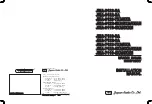
4
I N S T R U C T I O N M A N U A L
G X 8 5 0
used in accordance with the instructions, may cause harmful
interference to radio communications. However, there is no
guarantee that interference will not occur in a particular
installation. If this equipment does cause harmful interference
to radio or television reception, which can be determined by
turning the equipment off and on, the user is encouraged to
try to correct the interference by one or more of the following
measures:
•
Reorient or relocate the receiving antenna.
•
Increase the separation between the equipment and
receiver.
•
Connect the equipment into an outlet on a circuit different
from that to which the receiver is connected.
•
Consult your dealer or an experienced radio/TV technician
for help.
NOTE:
Changes or modifications to this unit not expressly
approved by the party responsible for compliance could void
the user’s authority to operate the equipment.
EU Regulatory Conformance
As certified by the qualified laboratory, the product is in
compliance with the essential requirements and other
relevant provisions of the Directive 1999/5/EC. Please note
that the above information is applicable to EU countries only.
OPERATING RULES
Priorities
•
Read all rules and regulations pertaining to priorities and
keep an up-to-date copy handy. Safety and distress calls
take priority over all others.
•
You must monitor Channel 16 when you are not operating
on another channel.
•
False or fraudulent distress calls are prohibited under law.
Privacy
•
Information overheard but not intended for you cannot
lawfully be used in any way.
•
Indecent or profane language is prohibited.
RADIO LICENCES
Ship Station License
When your craft is equipped with a VHF FM radio, you must
have a current radio station licence before using the radio.
It is unlawful to operate a ship station which is not licensed.
Inquire through your dealer or the appropriate government
agency for a Ship-Radiotelephone license. This license
includes the call sign which is your craft’s identification for
radio purposes.
Operators License
A restricted Radiotelephone Operator Permit is the license
most often held by small vessel radio operators when a
radio is not required for safety purposes. The restricted
Radiotelephone Operator Permit must be posted near the
radio or be kept with the operator.
Only a licensed radio operator may operate a radio. However,
non-licensed individuals may talk over a radio if a licensed
operator starts, supervises, ends the call and makes the
necessary log entries.
A current copy of the applicable government rules and
regulations is only required to be on hand for vessels in which
a radio telephone is compulsory. However, even if you are
not required to have these on hand it is your responsibility
to be thoroughly acquainted with all pertinent rules and
regulations.
RANGE
The range of VHF transmissions depends on antenna height,
transmitter power and the terrain over which the signals
pass. For a 5 watt handheld radio like the TX850, ship to
ship communications up to 5 nautical miles should be
possible. Using an external antenna should allow ship to ship
communication of 8 nautical miles or more. Ship to shore
ranges will often be greater due to the increased height of
the shore antenna.





































